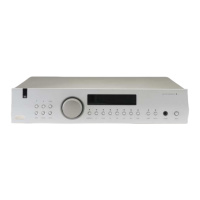Pre-amp input card.
In
troduction.
The pre-amp stage is a high-performance,
DC coupled design with microprocessor
control of input select, two independent tape
loops, electronic volume control and tone
bypass.
It features a discrete power supply and low-
noise linear circuitry to obtain exceptionally
low distortion and noise performance results.
Power supply stage
The secondary transformer output windings
from the main toroid transformer are
connected to
SK300
. The A.C voltage is
rectified and smoothed by
D300, D301, D306,
D307
and
C300, C301
. The unregulated
voltage should be around +/- 27 V obviously
this is dependent on the A.C level at the
mains inlet socket;
F300
and
F301
are the
secondary A.C s.m fuses these are rated at
2A.
The voltage regulators are discrete emitter
followers the
+15
voltage stage is described
below as the
–15 v
stage is effectively very
similar.
Q300
and
R300
act as a constant current
source, supplying around 7mA into
D310
.
C302 and C314 reduce ripple and broadband
noise on the zener diode. Q305 and Q306
form a complementary Darlington NPN
transistor, which is configured as an emitter
follower producing +15v at it’s output.
C303
is
to provide bulk charge storage and to reduce
the AC output impedance of the power
supply.
D302
prevents reverse bias of the supply
during power down.
Z301 is a conventional LM317 type circuit to
regulate the +15v rail down to +5v for the
tone and volume control circuits.
Input switching
Each of the inputs has a pair of diodes to the
+/- 15v rails to prevent static spikes from
causing damage to the CMOS multiplexors.
In addition, there is a simple resistor-
capacitor filter with a corner frequency of
approximately 340kHz to remove any
unwanted high frequency interference from
the signal. This uses high quality WIMA
polypropylene capacitors for the best
possible performance.
Z104 (left) and Z105 (right) are the main
input multiplexers, which are configured in a
“virtual earth” unity gain arrangement with
Z115
and
Z116
. This is an inverting circuit
topology and the phase is corrected by the
inverting volume control.
Z115B
(left) and
Z116B
(right) are the
integrating servos, which remove any D.C
coefficient from the Analogue input switching
stages before the signal is passed onto the
following stages,
R180
and
C147
(left) form a
filter to remove any broadband noise from the
servo output and to improve the speed
response.
Z100
–
Z103
are the Tape output selectors
these are non-inverting and the outputs are
again buffered by
Z9
a/b and
Z10
a/b before
arriving at the two tape loop outputs.
Z106
is configured as a double pole
changeover switch and is used to select the
tone controls or direct by pass mode. (See
below for more information).
Tone controls
The tone control stage is non-inverting and
uses a gyrating bell filter for the Bass and a
simple shelving filter for the high frequencies,
the left channel only will be described.
The input is attenuated by –6dB and biased
to a voltage of +2.5v D.C by
C111
,
R113
,
R112
,
R110
,
R111
and
C110
. This is so the
signals fall within the 0 – 5v D.C required by
the digital potentiometer
Z108
.

